For as long as I can remember I have been fascinated by technology. When I was young I used to make circuits from batteries, torch bulbs and bits of wire, wood and metal.
Even before our family got its first computer in 1987 (an Amstrad PC1512) I was making the computers at my first primary school do things that few other people could. The wordprocessing package often inserted white blocks into the text when you pressed the wrong key, and these could not be deleted in the normal way. I was often called upon to get rid of them. I also did a lot of programming in "LOGO", the turtle graphics language. I remember writing LOGO subroutines to draw all the letters of the alphabet, and putting them together to write my name!
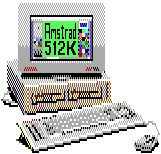
The Amstrad PC1512 was a great computer for it's time, being one of the most powerful PCs around at the time. It was also one of the first PCs to come with a mouse and graphical operating system (in this case GEM, the same interface now used on the Atari ST computer). The version we had also came with a colour monitor, two 360Kb, 5.25" floppy disk drives and a massive 512Kb of memory. Software supplied was MS-DOS, DOS-PLUS, the GEM suite (which included Desktop, the Locomotive Software's "BASIC2" programming language and GEM PAINT), Migent Ability (the Microsoft Office of its day) and four games (Bruce Lee, Tag Team Wrestling, PSI-5 Trading company and Dambusters). The 20Mb hard disk was an optional extra we did without, and 3.5" floppy disks were unheard of. We also bought a 24 pin dot matrix printer, which came with a wordprocessor called "WordStar".
GEM has now become open source software and can be obtained from here. If you just want to convert your old Paint pictures to a more useful format or run your old Locomotive BASIC2 programs again, try here. For copies of the original Amstrad 1512/1640 boot disks, look here.
I wrote some 200 programs with BASIC2, mostly simple games and graphics programs. There was no ability to make sound apart from a single beep, the frequency of which was fixed. In the years between 1986 and 1994 I discovered DOS, got a copy of Borland Turbo C 2.01 for Christmas (which can now be downloaded from here if you want a small, fast C development environment for DOS), upgraded the computer to a gigantic 640K of memory, bought various computer magazines, added sound to BASIC2 (thanks to Gordon E. Peterson II), drew my first Mandelbrot set, managed to get Microsoft Windows 2.0 running from floppies, eliminated the Dir II virus from my system with only the help of CHKDSK, and wrote my first couple of really playable games - Rockfall, Mr X, the obligatory Tetris clone and Cool Dude. See the Software page if you want to download these.
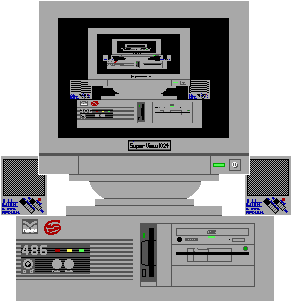
By 1994, I was getting very fed up with swapping disks in and out and receiving programs on 3.5" disk, which I was unable to use, and programs telling me I needed a more expensive computer to run them on. I managed to persuade my parents to make up the money I needed to buy a new computer, and I settled for a Fountain multimedia 486DX/33 system with a massive 4Mb of RAM, whopping 250Mb hard disk, state-of-the art double speed CD-ROM drive, 16-bit Soundblaster compatible card and Super VGA display system. It also came with the latest software: MS-DOS 6.2, Windows for workgroups 3.11, Encarta 1994 and Microsoft Works. Two years on, and deja-vu - increasing numbers of the programs I used to get every month with my PC Plus subscription refused to run. Unlike the 1512, though, this computer has capacity for expansion. In Easter 1999 it had a serious upgrade, to an AMD K6/2 processor running at 350MHz, 64Mb of RAM, a 4.3Gb hard disk, a 24x CD-ROM drive and Windows 95 OSR2.
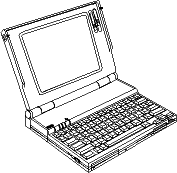
In the autumn of 1996 I bought my first laptop, a Compaq LTE Lite/25 with 386SL processor, 80Mb hard disk and monochrome VGA screen. It was a very good deal, in mint condition, second hand, for £100. I thought it would come in very handy at university. Although it seems slow and cramped compared to the Fountain, not having the responsibility of multimedia or many Windows programs meant that I could squeeze an amazing amount of stuff onto the hard disk. Most of the software I had on this computer was highly customised. The machine has now been passed down to my brother Chris.
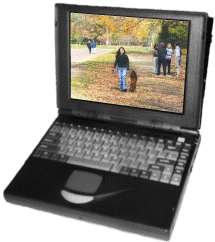
However, after 2 years, going to the College computer room whenever I wanted to do so much as send an email got to be a real pain in the neck, particularly since all the computers there were either 386s running OS/2 (which they have since replaced with NT machines) or Apple Macs, which crashed a lot and were generally very annoying to use, especially if you wanted to do anything even slightly difficult so after spending the summer of 1999 at work (designing a website for a local company) I saved up enough money to buy myself this - a laptop from Martin Computer Services with an AMD K6/2 processor running at 400MHz, 64Mb of RAM, a 6.4Gb hard disk and a colour 800x600 screen. It usually runs Windows 98 Second Edition, but has on occasion been known to run Debian GNU/Linux.
In the summer of 2001, while doing some coding on this machine, I noticed a funny smell - something like burning rubber. It didn't seem important at the time, so I ignored it and continued with what I was doing. Moments later, smoke started pouring out of the machine's ventilation system! Don't buy unbranded laptops, friends - it's not worth it!
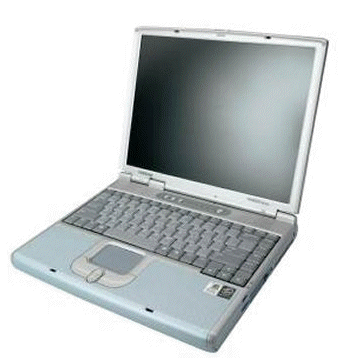
Fixing it was going to be expensive, so I decided I might as well get a new laptop - a Samsung VM8000 with 800MHz Intel Celeron processor, 128Mb RAM, 10Gb of hard disk, 1024x768 screen, built-in modem and networking, and Windows ME. ME, by the way, I would recommend to new users but if you're used to Windows 98 and are happy with it, ME would probably just annoy you - it tries very hard to protect users from themselves, which makes doing anything even slightly unusual exponentially more difficult. It took me weeks, for example, to figure out how to get the UK keyboard layout in a DOS box in the absence of a CONFIG.SYS file. The other thing that annoys me about this machine is that it has a ventilation port on the bottom, so you can only use it on a hard surface. I end up carrying it around on a plastic box so I can use it on my bed, my lap and the sofa. It would have been better if this flat surface had been built in to the machine, as that would have effectively made it lighter and thinner. The only reason I can think of that they didn't is so that the "on paper" statistics for thickness and weight look better.
This machine has since been upgraded to Windows XP so that I can use it to log in to work from home.

I had been meaning to build my own machine for a while, and after working at Microsoft for a while I finally had the money to do it. With some advice from other Microsofties, I put together this machine. It has an Athlon XP 1800+ processor, an MSI KT266A motherboard, 512Mb Crucial PC2100 RAM, a LeadTek GeForce 3 Ti200 video card with 128Mb of RAM, Seagate 80Gb Hard Drive, SoundBlaster Audigy, InWin S500P case, Samsung SyncMaster 700IFT monitor, Epson scanner, Lite On CDRW and DVD (region hacked) drives, floppy drive, 2 ethernet cards and a cable modem internet connection. It has since been upgraded with a video capture card, and 320Gb of additional hard drive. It runs Windows XP usually. I also have a Mandrake Linux partition but I hardly ever use that.